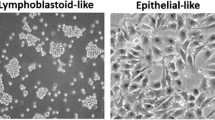Summary
The analysis of the gel electrophoresis banding patterns and relative migration distances for the individual isoforms of intracellular enzymes, such as lactate dehydrogenase, purine nucleoside phosphorylase, glucose-6-phosphate dehydrogenase, and malate dehydrogenase, is used routinely in the biopharmaceutical industry for confirmation of cell line species of origin. In the present study, the sensitivity of the technique (AuthentiKit™, Innovative Chemistry, Marshfield, MA) for determining interspecies cell line cross-contamination was examined. Extracts were prepared from a CHO-K1 line (AA8, Chinese hamster), MRC-5 (human) cells, and L929 (mouse) cells and from several proportional mixtures of the various binary combinations of cells. The isoenzymes were analyzed according to standard procedures for the technique. Contamination of MRC-5 cells with CHO-K1 or with L929 cells was clearly detectable with each enzyme analyzed. Similarly, the contamination of L929 or CHO-K1 cells with MRC-5 cells was readily apparent with each enzyme. On the other hand, contamination of CHO-K1 cells with L929 cells was only detected with lactate dehydrogenase analysis, and contamination of L929 cells with CHO-K1 cells was not detected with any of the four enzymes examined. For the latter case, the analysis of an additional enzyme (peptidase B) was required. The results indicate that interspecies cross-contamination should be detectable with isoenzyme analysis if the contaminating cells represent at least 10% of the total cell population.
Similar content being viewed by others
References
Anonymous. The AuthentiKit™ system. Handbook for cell authentication and identification. 2nd ed. Marshfield, MA: Innovative Chemistry; 1988:31–46.
Halton, D. M.; Peterson, W. D., Jr.; Hukku, B. Cell culture quality control by rapid isoenzymatic characterization. In Vitro 19:16–24; 1983.
Hay, R. J. The seed stock concept and quality control for cell lines. Anal. Biochem. 171:225–237; 1988.
Hay, R. J.; Chen, T. R.; Macy, M. L., et al. Reply to “Cells, lines and DNA fingerprinting.” In Vitro Cell. Dev. Biol. 28A:593–594; 1992.
Hukku, B.; Halton, D. M.; Mally, M., et al. Cell characterization by use of multiple genetic markers in eukaryotic cell cultures. In: Acton, R. T.; Lynn, J. D., eds. Eukaryotic cell cultures, basics and applications. New York: Plenum Press; 1984:13–31.
MacLeod, R. A. F.; Drexler, H. G.; Haene, B. Cells, lines and DNA fingerprinting. In Vitro Cell. Dev. Biol. 28A:591–592; 1992.
Montes de Oca, F.; Macy, M. L.; Shannon, J. E. Isoenzyme characterization of animal cell cultures. Proc. Soc. Exp. Biol. Med. 132:462–469; 1969.
Nelson-Rees, W. A. The identification and monitoring of cell line specificity. Prog. Clin. Biol. Res. 26:25–79; 1978.
O’Brien, S. J.; Shannon, J. E.; Gail, M. H. A molecular approach to the identification and individualization of human and animal cells in culture: isozyme and allozyme genetic signatures. In Vitro 16:119–135; 1980.
Patterson, R. M.; Selkirk, J. K.; Merrick, B. A. Baculovirus and insect cell gene expression: review of baculovirus biotechnology. Environ. Health Perspect. 103:756–759; 1995.
Peterson, W. D., Jr.; Ottenbreit, M. J.; Hukku, B. Isoenzyme analysis in cell characterization. In: Levine, E. M.; Stevenson, R. E.; Patterson, M. K., Jr., eds. Uses and standardization of vertebrate cell cultures. In Vitro Monograph No. 5, Gaithersburg, MD: Tissue Culture Association; 1984:116–124.
Peterson, W. D., Jr.; Simpson, W. F.; Hukku, B. Cell culture characterization: monitoring for cell identification. In: Jakoby, W. B.; Pastan, I., eds. Cell culture, methods in enzymology. Vol. LVIII. San Diego, CA: Academic Press; 1979:164–178.
Steube, K. G.; Grunicke, D.; Drexler, H. G. Isoenzyme analysis as a rapid method for the examination of the species identity of cell cultures. In Vitro Cell. Dev. Biol. 31:115–119; 1995.
Wright, W. C.; Daniels, W. P.; Fogh, J. Distinction of seventy-one cultured human tumor cell lines by polymorphic enzyme analysis. J. Natl. Cancer Inst. 66:239–248; 1981.
Author information
Authors and Affiliations
Rights and permissions
About this article
Cite this article
Nims, R.W., Shoemaker, A.P., Bauernschub, M.A. et al. Sensitivity of isoenzyme analysis for the detection of interspecies cell line cross-contamination. In Vitro Cell.Dev.Biol.-Animal 34, 35–39 (1998). https://doi.org/10.1007/s11626-998-0050-9
Received:
Accepted:
Issue Date:
DOI: https://doi.org/10.1007/s11626-998-0050-9




